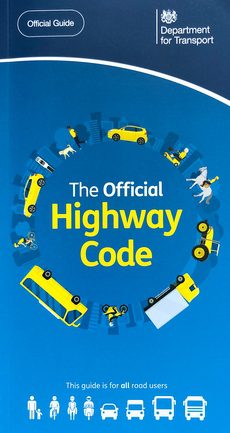
With the streets crowded and your regular spot possibly commandeered by others, you might find yourself facing the inconvenient reality of a vehicle parked outside your driveway.
This raises a critical question: Is this act illegal, and do you have any recourse if it happens to you? We delve into the rules and regulations to offer you the definitive answer.
The Rules on Parking Across a Driveway
The legality of parking across a driveway, especially one with a dropped kerb, isn’t as black and white as many would hope.
When it comes to interpreting the Highway Code, understanding the distinction between legal requirements and guidelines becomes crucial.
Understanding the Highway Code
The Highway Code is a compilation of rules, guidelines, and advice aimed at ensuring road safety and order. Not all the rules outlined in the Code carry the same weight.
Legal requirements are marked by the imperative “MUST/MUST NOT” and failing to adhere to these is considered a criminal offence, potentially leading to fines, penalty points, or disqualification from driving.
On the other hand, not following the advisory parts of the Code won’t directly result in prosecution, but they can influence court proceedings under the Traffic Acts.
Highway Code Rule 243
Rule 243 advises against parking “in front of an entrance to a property”, yet it doesn’t anchor this advice with a specific law, leading to a somewhat grey area.
In essence, while it’s highly discouraged, it may not always constitute an illegal action to park across someone’s driveway, particularly in the absence of a dropped kerb.

Legal Exceptions
However, this ambiguity dissipates under certain conditions that unequivocally render parking across a driveway illegal:
- Parking Restrictions: If the vehicle is parked on a street subject to specific parking restrictions, it may then violate traffic laws, enforceable by local authorities or the police.
- Highway Code Rule 242: Parking that leaves a vehicle in a dangerous position or causes unnecessary obstruction is a clear breach. This is backed by the Road Traffic Act 1988, section 22, and/or the Road Vehicles (Construction & Use) Regulations 1986, regulation 103.
The Legal Loophole: Parking on Someone Else’s Driveway
Surprisingly, parking on another person’s driveway falls into a legal loophole. As driveways are considered private property, the issue transitions from a public order to a civil matter, which neither the police nor the council are typically mandated to address.
The exception arises with vehicles that are untaxed, uninsured, or without a valid MOT, where councils are obligated to act, albeit with low priority unless the vehicle is deemed abandoned.
Areas Where You Must Not Park
While the nuances of parking across a driveway may involve a grey area, certain locations are unequivocally off-limits for parking.
Understanding these restrictions is crucial for all drivers to avoid penalties and contribute to road safety.
Absolute No-Park Zones
The law is crystal clear on several no-go areas for parking. These include:
- School entrance markings: To ensure the safety of children, parking here is strictly prohibited.
- Pedestrian crossings, including the zig-zag lines: These areas need to be clear to provide visibility and safety for pedestrians.
- Marked taxi bays: These spaces are reserved exclusively for taxis.
- Tram or cycle lanes during operational hours: Parking here could obstruct the path of trams and cyclists, posing safety risks.
- Red lines: Typically found in high-traffic areas, parking on red lines is strictly controlled to maintain traffic flow.
- Spaces reserved for Blue Badge holders, residents, or motorbikes (unless entitled to do so): These spots are designated for specific users, and unauthorized parking could greatly inconvenience them.
Conditional No-Park Zones
There are also areas where parking is usually prohibited, except under certain conditions, such as being caught in stationary traffic:
- Anywhere that would prevent access for Emergency Services: It’s crucial that emergency vehicles can move freely without obstruction.
- At or near a bus/tram stop: These areas need to be accessible for public transport users.
- Opposite or within 10 metres of a junction: Parking too close to a junction can obscure visibility and create dangerous conditions.
- Generally, if you see zig-zag lines, red or double yellow lines, parking is not permitted. These markings are there to denote areas where parking could create hazards or obstruct traffic.
Understanding these restrictions not only helps in avoiding fines but also contributes to a safer and more orderly traffic environment.
It’s vital for drivers to be aware of and comply with these regulations, ensuring that their actions do not inadvertently put others at risk.
Conclusion
Navigating the complexities of parking laws, especially regarding the legality of parking across driveways, requires a nuanced understanding of the Highway Code and local regulations.
While some aspects remain open to interpretation, the overarching principle is clear: parking practices should always prioritize safety, accessibility, and legal compliance.
By adhering to the guidelines and legal requirements set forth in the Highway Code, drivers can contribute to a safer, more efficient road network for everyone.
Whether it’s respecting no-park zones or understanding the specifics of parking on private property, informed decisions can help mitigate disputes and ensure that you’re on the right side of the law.
While finding a parking spot in today’s crowded urban landscapes may present a challenge, familiarity with parking rights and restrictions can alleviate some of the stress associated with it.
Hopefully, this article has provided clarity on where and when parking is permissible, empowering you to make informed choices and, when necessary, take appropriate action against unauthorized parking on your property.


